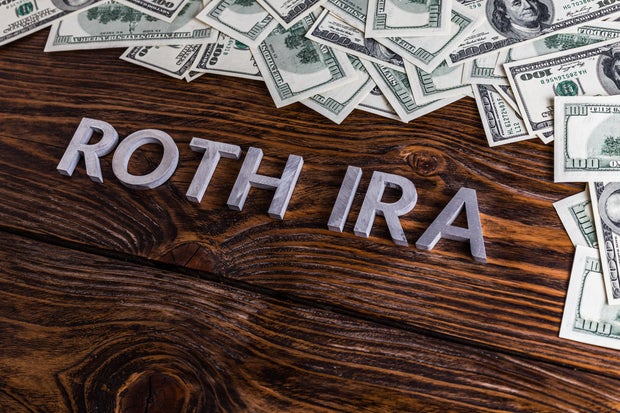Rules for Roth IRAs: Is there an income limit for contributions?
A Roth IRA is a type of individual retirement account (IRA) that offers tax-free growth. In short, you pay taxes on contributions upfront, let the account grow over time and enjoy tax-free distributions down the road.
This may sound great but these accounts won't work well for everyone. Your annual income must fall under a certain limit to avoid penalties.
But what are the Roth IRA income limits, and how do the penalties work? Here's what you need to know.
What is the income limit for a Roth IRA?
The income limits on Roth IRAs are based on your modified annual gross income (AGI). If your earnings are above the maximum limit, you won't be able to make any contributions without incurring a penalty. Additionally, the amount you can contribute without a penalty decreases if your income passes the minimum phase-out limit.
If you're interested in finding out more about Roth IRA's, learn more today about how to grow your money tax-free.
2022 Roth IRA maximum income limits
Here are the maximum income limits for Roth IRAs in 2022:
- $214,000 if you're married filing jointly or a qualifying widower
- $144,000 if you're head of household, single or married filing separately and living separately
- $10,000 if you're married filing separately and living together
2022 Roth IRA minimum phase-out limits
Here's where the Roth IRA contribution phase-outs begin in 2022:
- $204,000 if you're married filing jointly or a qualifying widower
- $129,000 if you're head of household, single or married filing separately and living separately
- $0 if you're married filing separately and living together
When your income is in the phase-out range, you can use the IRS's worksheet to calculate your reduced contribution amount. If you land below the phase-out threshold, you'll be able to contribute the maximum amount for that year – as long as you've earned at least an equal amount of taxable income.
It's always good to prepare for retirement, no matter your age. A Roth IRA could be key to a successful retirement.
The maximum contribution limit can change yearly, but it's currently at $6,000 for 2022 ($7,000 if you're 50 or older).
Let's look at an example of how these income limits work. If you are a 40-year-old single filer with a modified AGI of $75,000, you could contribute the full $6,000 to your Roth IRA. You would qualify because you made at least $6,000 in taxable income but less than the $129,000 minimum phase-out limit. However, if you made $135,000, you would not be able to contribute without incurring a penalty. Further, if you made $3,000 in taxable income, you would only be able to contribute up to $3,000.
What happens if you exceed the Roth IRA income limit?
The IRS charges a 6% excise tax on excess Roth IRA contributions for each year they remain in an account.
For example, say your income exceeds the maximum limit but you deposit $6,000 into a Roth IRA account. You could end up owing around $360 per year (plus 6% of your interest earnings on the $6,000). The tax would continue each year for as long as the excess amount stays in your account.
Have you made excess contributions? The IRS won't charge you the 6% tax if you withdraw them (and your resultant earnings) by the date your tax return is due for that year.
What is the Roth IRA 5-year rule?
Roth IRA withdrawals must be deemed "qualified distributions" for them to be tax-free. In order for a distribution to be qualified, you must be at least 59 ½ years old when you request it and must satisfy the five-year rule. The five-year rule requires that five years have passed since the tax year when you made your first Roth IRA contribution.
So if you open a Roth IRA at age 57 and try to take a distribution when you turn 60, it wouldn't be tax-free because you wouldn't yet satisfy the five-year rule. You would have to wait until you were at least 62.
Roth IRA vs. 401(k): What's the difference?
Traditional 401(k) accounts differ from Roth IRAs in a few key ways.
- Employers offer 401(k) plans to employees while individuals establish Roth IRAs directly with financial institutions.
- 401(k) contributions are made using pre-tax dollars and withdrawals are subject to income taxes — the opposite is true for Roth IRAs.
- 401(k)s don't have income limitations like Roth IRAs. You can also contribute much more each year and may benefit from employer matching.
- 401(k)s typically require you to take distributions once you turn 72, while Roth IRAs never require distributions.
What about a Gold IRA?
Some investors add gold to their portfolio to both diversify their savings and to help as a hedge against inflation. The optimal time to purchase gold, according to experts, is when inflation is high and a potential recession is in play. Although older investors traditionally buy gold, it's actually riskier for them and a better idea for younger people. That's because older investors need more reliable, income-producing investments. Younger people have more time to save for retirement, however, and can thus experiment a bit more with their income.
The right time to buy gold, then, is relative. And while it shouldn't be the only investment vehicle, it can provide additional benefits if used in conjunction with other, more traditional ones like a Roth IRA. Learn more about Gold IRAs to see if they're right for you.
Should you get a Roth IRA?
A Roth IRA can be a valuable account that helps you save for retirement and enjoy tax-free growth. It's especially useful if you expect to have higher tax rates later in life.
However, it won't be a good option if your annual income level is too high. Additionally, if your employer offers a 401(k) plan and matches your contributions, that account could very well offer a higher return on investment.
The right choice will depend on your employment situation, annual income, tax filing status and expected future tax rates. Be sure to weigh a Roth IRA against other options like 401(k)s and traditional IRAs. And, keep in mind, you don't have to choose just one. In some situations, it can be beneficial to split your retirement funds up amongst multiple types of accounts – such as a Roth IRA and 401(k).
Do you think you would benefit from a Roth IRA? Start saving today.






